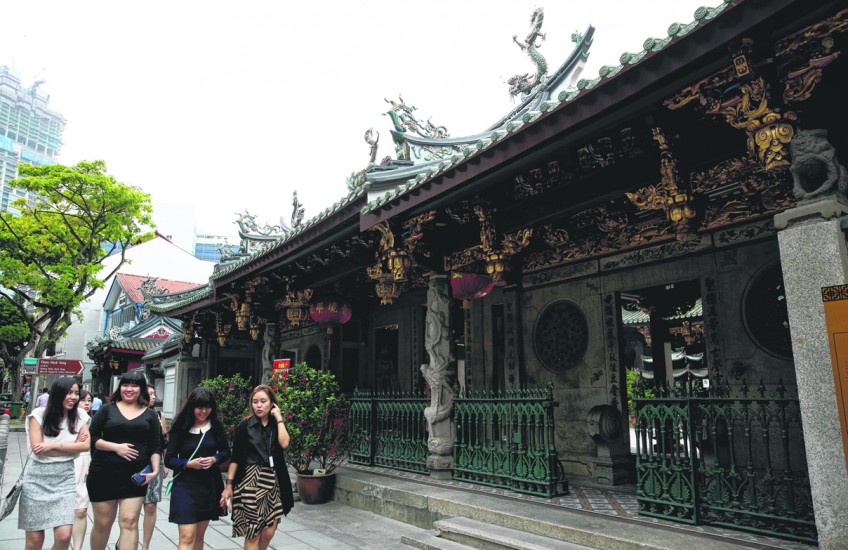Havens for stressed office workers

TELOK Ayer Street once faced the seafront, serving as the docking bay for the boats of early immigrants in the 1820s.
It was here that new Chinese and Muslim immigrants alike set up altars and worship houses to give thanks for their safe arrival.
Nearly two centuries later, while the street, whose name in Malay means water bay, is no longer near the sea, places of worship here have stood the test of time.
Chief among them, standing in the heart of the street, is the Thian Hock Keng Temple, or the Temple of Heavenly Happiness.
Initially a simple shrine set up by the Hokkiens in 1819 dedicated to the Goddess of the Sea, Mazu, it was later transformed into Thian Hock Keng and completed in 1842 with funding from wealthy merchants such as Tan Tock Seng.
Gazetted as a national monument in 1973, the temple has won four architectural awards, including an honourable mention from Unesco as a Culture Heritage Conservation Building in 2001.
The temple is an architectural wonder - not a single nail was used in the original mortise construction.
Both locals and tourists alike are drawn by its rich history and sense of serenity.
An employee of the temple, who wanted to be known only as Mr Hong, said in Mandarin: "Locals usually come either in the morning or during lunch hours. It gets especially busy on weekends."
"Tourists also come down daily to visit the temple and learn more about its heritage," said the 53-year-old, who has worked there for more than 20 years.
Tour guide Johnson Tan, 50, said: "This temple is a hot favourite among tourists. It is more traditional and has a lot of history. On average, I bring around four to five groups here every month."
Even tourists from China, which has countless temples with longer histories, are impressed.
Visitor Li Yong Kang, 24, who is from Guangzhou, said: "It really is a symbol of traditional Chinese culture.
"It's also very interesting that the temple is surrounded by skyscrapers and office buildings. You don't see that in Guangzhou."
And it is a temple frequented by devotees and one where offerings of joss sticks and candles are never in shortage.
Madam Low Yin Ching, 42, an administrator, visits the temple on the first day and 15th day of each lunar month.
"Lots of other office workers come by as well. It is very convenient for us to be able to pay respects to the deities."
A short distance away from Telok Ayer Street, also within the Central Business District, is the Yueh Hai Ching Temple along Phillip Street, which was also set up to pay respects to Mazu.
One of the oldest Taoist temples in Singapore, it too started as a simple shrine, set up by Teochew settlers in 1826.
It had its first major renovation in 1895, undertaken by its owner Ngee Ann Kongsi.
More recently, restoration works completed in January last year had earned it the Urban Redevelopment Authority Architectural Heritage Award last October, and the Unesco Heritage Award in April.
It is the only temple in Singapore besides Thian Hock Keng that was honoured with a bian e, a horizontal inscribed board bearing its name, from Qing emperor Guangxu in 1907.
The temple, gazetted as a national monument in 1996, features a spacious forecourt surrounded by skyscrapers.
Some office workers say stepping into the temple feels like entering an oasis of calm.
"You can't really hear the hustle and bustle of the Central Business District in here," said Ms Linda Chai.
The 50-year-old, who runs her own business in the area, said: "I come down every two to three days. It gives me a sense of calmness and safety whenever I'm in here."
Miss Angela Han, 31, an accounting executive, similarly feels a sense of peace in the temple.
"This is my first time visiting the temple. I usually rush past because I don't have time. But I had some time today, so I finally paid it a visit," she said.
"It is very peaceful and quiet. It's very different the moment you step outside. I would come by more often if I had the time."
Mr Sam Chin, 28, who accompanied Ms Han on her visit, said: "I'm not a Buddhist, but I do think it's quite nice that there is a temple in the middle of the CBD."
"It's a very serene place. The noise stops once you step inside the temple," the shipping industry worker added.
"It feels as if, for a moment, whatever's going on outside doesn't exist."
ngilaine@sph.com.sg
lookww@sph.com.sg

This article was first published on June 26, 2015.
Get a copy of The Straits Times or go to straitstimes.com for more stories.